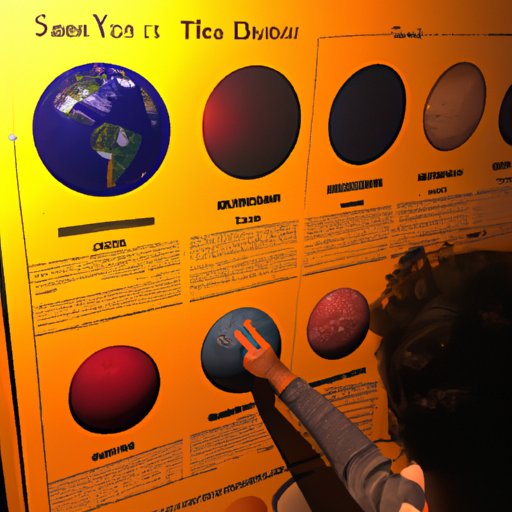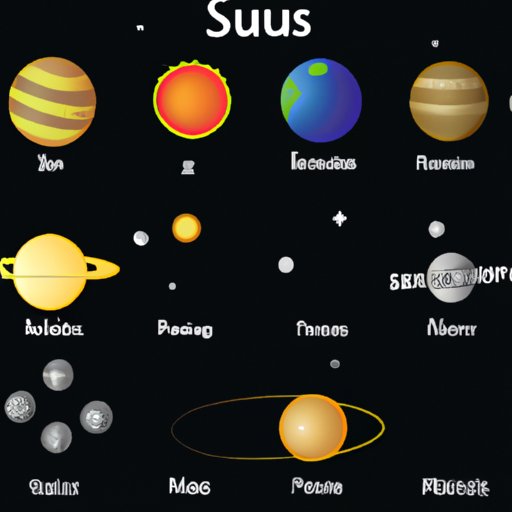Introduction
The solar system is a collection of eight planets, dwarf planets, asteroids, comets, meteors, and other objects that orbit around a star at the center of the system – the Sun. Understanding how these objects interact with each other and how they are held in place by gravity is an important part of understanding the universe we live in. This article will explore the structure of the solar system, the role of gravity, and the formation and history of the system.

Exploring the Structure of the Solar System
The solar system is made up of eight planets, which all orbit around the Sun. The closest planet to the Sun is Mercury, followed by Venus, Earth, Mars, Jupiter, Saturn, Uranus, and Neptune. Each of these planets has its own unique characteristics and features, but they all share one thing in common – they all orbit around the Sun. The planets follow elliptical paths that are determined by the laws of gravity.
The Sun plays an important role in the solar system, as it is the source of light and heat for the planets. It is also the largest object in the system, making up 99.8% of the mass in the solar system. All of the planets, asteroids, and other objects in the system are held in place by the Sun’s gravity.

How Planets Orbit the Sun
The planets in the solar system are held in their orbits by the force of gravity. Gravity is the attractive force between two objects, and it is what causes objects to move in a curved path around the Sun. The strength of this force depends on the masses of the two objects – the more massive an object, the stronger the gravitational force it exerts.
Gravity affects the motion of the planets in several ways. First, it causes them to move in an elliptical path around the Sun. Second, it causes them to move faster when they are closer to the Sun, and slower when they are further away. Finally, it keeps them in their orbits and prevents them from flying off into space.
Understanding the Role of Gravity in the Solar System
Gravity is one of the most important forces in the universe, and it plays an essential role in the solar system. Without gravity, the planets would not stay in their orbits and the solar system would not exist. Gravity is also responsible for keeping the planets in the same plane, which is why all of the planets in the solar system orbit in nearly the same plane.
The force of gravity is determined by the mass of an object. The more massive an object, the greater the force of gravity it exerts. This means that objects with more mass, such as stars and planets, have a stronger gravitational pull than objects with less mass, such as asteroids and comets.

The Different Types of Objects in the Solar System
The solar system is made up of a variety of different types of objects, including planets, dwarf planets, asteroids, comets, meteors, and meteorites. Planets are large, round objects that orbit the Sun and have their own moons. Dwarf planets are similar to planets, but they are smaller and do not have their own moons. Asteroids are small, rocky objects that orbit the Sun, while comets are icy objects that originate in the outer reaches of the solar system.
The asteroid belt is located between the orbits of Mars and Jupiter, while the Kuiper Belt is located beyond the orbit of Neptune. Both of these regions contain many asteroids and comets. Meteors are pieces of rock or metal that enter Earth’s atmosphere and burn up, while meteorites are pieces of rock or metal that survive the journey through the atmosphere and land on the ground.
Examining the Formation and History of the Solar System
The formation of the solar system is a complex process that is still being studied by scientists. The current theory is known as the nebular theory, which states that the solar system was formed from a cloud of gas and dust known as a nebula. Over time, this cloud of gas and dust collapsed under its own gravity, forming the Sun and the planets.
Astronomers have been able to study the history of the solar system by looking at the formation of stars and galaxies in the universe. They have also been able to estimate the age of the solar system by studying the radioactive decay of certain elements. Based on this evidence, astronomers believe that the solar system is approximately 4.6 billion years old.
Conclusion
In conclusion, the solar system is a fascinating and complex system of planets, dwarf planets, asteroids, comets, meteors, and other objects that orbit around the Sun. Understanding the structure of the solar system, the role of gravity, and the formation and history of the system is essential for appreciating the beauty of the universe we live in. From the laws of gravity that keep the planets in their orbits to the nebular theory that explains the formation of the solar system, there is much to learn and explore.
(Note: Is this article not meeting your expectations? Do you have knowledge or insights to share? Unlock new opportunities and expand your reach by joining our authors team. Click Registration to join us and share your expertise with our readers.)
